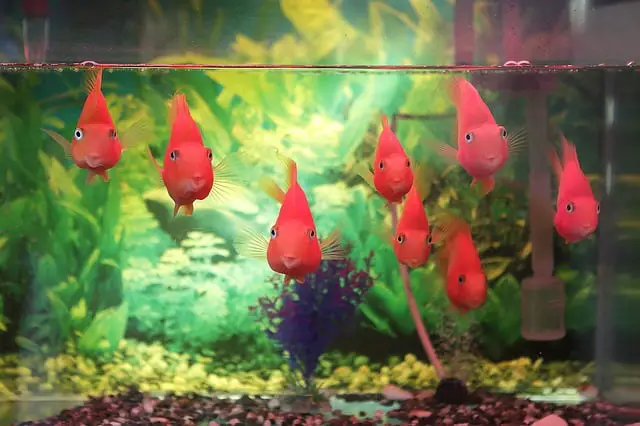The thought of any of my aquariums cracking terrifies me! There would not only be the destruction of my aquarium and death of the fish but what about my furniture and flooring? It would just be an awful mess. It has bothered me enough recently that I felt I needed to go over how a tank cracks and what can be done to avoid this from happening in the first place.
Why do fish tanks crack? Fish tanks crack mostly because of two reasons. One is because the manufacture of the tank was in poor quality and the silicone is not working as it should. The second reason is the aquarium stand is not level. An un-level aquarium causes undue stress on one location of a tank creating cracks.
Top Two Reasons an Aquarium Will Crack
- Poor manufacturing. If a tank is not sealed properly with a strong bonding silicone, the glass panels can pull and tug on the joins causing cracking or separation and ultimately leaking. Another sign of poor manufacturing are aquariums made of glass that do not have thick enough glass. Always purchase aquariums from trusted dealers with solid reputations and ratings.
- An un-level base. This is probably the more common issue of cracking tanks. If your aquarium stand is not level, your tank will not be level. This means the weight is shifted towards the lower part of the tank. The stress on the glass could be enough to cause cracking. It might be hard to get the tank to a precise level but that’s okay because being off just slightly can be remedied with a rubber pad or styrofoam made for this application.
Can Aquarium Glass Actually Break or Leak?
Yes, glass breaks and your aquarium will leak wherever there is silicone. Some larger aquariums will have what is called a center bridge. Essentially it is a support spanning from front to back located top center of tank. It helps to support the structure because a full aquarium is extremely heavy. If there is even the slightest of movement, there is a lot of weight pushing against the glass.
I have found that a tank is more likely to leak first, giving you time to repair it versus a full on break in the glass. If it was a common event, glass aquariums just wouldn’t sell.
What Happens if Aquarium Glass Breaks?
If aquarium glass breaks, things are going to get wet. If it’s just a crack and the tank only leaks, consider yourself lucky. Just make sure to empty the tank before glass breaks away. Everyone has seen the terrible video clips of big tanks breaking and water flowing out, destroying everything! I don’t think a tank at home will be that dramatic, however, it can cause some damage.
Luckily for aquarium owners though is that tanks usually leak first along a seam before it will ever straight out break. Not to say that that doesn’t happen because it does.
How to Find a Leak in a Fish Tank?
This is super easy. Once a month, check on the outside of the tank along every seam that has silicone. Check for droplets of water. If you spot any, you might have a leak. Visually check the glass as well. If it’s a new tank you will have to fill it to find leaks.
Can You Fix a Cracked Aquarium?
No, if it’s cracked glass, I wouldn’t even try to fix it. Empty the tank immediately. You could try taking off the cracked panel and getting a new piece of glass or, for the price of a used tank, just buy one of those. It’s up to you.
How do I Stop My Aquarium From Leaking?
As previously mentioned, to take preventative measures, make sure to purchase aquariums only from reputable manufacturers. Leveling the tanks base properly, is another great way to stop a tank from leaking.
Something I haven’t mentioned yet, which is worth bringing up, is leaving trim on the tank that comes with the tank. I have seen some videos on YouTube that show the host cutting off the PVC edging around the tops of aquariums to give them a cleaner look. As nice as they look after, without the extra plastic trim around the edge, the trim is there for a reason. The reason is to provide support for the glass walls of the aquarium. So why purposely weaken the strength of the tank? If the plastic trim doesn’t appeal to you, then purchase a different tank.
Want to see why you should own a 40 gallon breeder tank? Find out here.
How often do Fish Tanks Explode?
I don’t know of any statistics for fish tanks exploding. All I can tell you is I have never had it happen to me and I have never heard of any of my local fish stores talking about any of their tanks exploding. It obviously doesn’t happen very often.
If you purchase a good tank and take the necessary precautions to set it up level and correctly, you shouldn’t ever have an issue.
Should I Reseal My Aquarium?
If you find that the silicone has a leak, the best thing you can do is empty the tank below the area that needs to be resealed. Scrape the old silicone off and, using a safe for aquarium silicone, apply some on the seam wiping it down a bit with a wet finger to smooth it out.
If it doesn’t appear that there is a very big leak then you can keep water in the tank below the repair but if the whole length of silicone from base of tank to the top needs to be scraped off and resealed, you are probably better off emptying the tank completely and putting the fish in another tank until the repairs are complete and their tank is ready for them again.
Aqueon has a silicone made for this purpose and is as good as any other brand on the market. If you want to check it out online at Amazon, follow the following link. Aquarium sealant.
Do Acrylic Aquariums Leak?
A newer material that is being used for aquariums now is acrylic. Acrylic is lighter than glass and stronger. It is also more expensive than its glass counterpart. Acrylic tanks should not leak as they are all one piece where a standard rectangular glass tank is 5 pieces sealed together.
So if you have the money for acrylic, I would definitely go this way. I have a really nice acrylic tank listed on my recommended aquariums page which can be found through this link.
Conclusion
You should have a really good grasp now on why a fish tank would crack along with some knowledge on how to start your tank properly to prevent cracking. Level the base of the tank first before filling the aquarium. A little bit of prep up front will save you a lot of grief down the road. Good luck, fellow hobbyists and happy fish keeping!
Related Aquariums-at-Home Articles.
50 Gallon Acrylic Aquarium Review.






